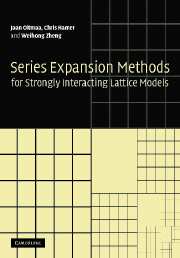Book contents
- Frontmatter
- Contents
- Preface
- 1 Introduction
- 2 High- and low-temperature expansions for the Ising model
- 3 Models with continuous symmetry and the free graph expansion
- 4 Quantum spin models at T = 0
- 5 Quantum antiferromagnets at T = 0
- 6 Correlators, dynamical structure factors and multi-particle excitations
- 7 Quantum spin models at finite temperature
- 8 Electronic models
- 9 Review of lattice gauge theory
- 10 Series expansions for lattice gauge models
- 11 Additional topics
- Appendix 1 Some graph theory ideas
- Appendix 2 The ‘pegs in holes’ algorithm
- Appendix 3 Free graph expansion technicalities
- Appendix 4 Matrix perturbation theory
- Appendix 5 Matrix block diagonalization
- Appendix 6 The moment–cumulant expansion
- Appendix 7 Integral equation approach to the two-particle Schrödinger equation
- Appendix 8 Correspondences between field theory and statistical mechanics
- Appendix 9 Computer programs
- Bibliography
- Index
1 - Introduction
Published online by Cambridge University Press: 06 January 2010
- Frontmatter
- Contents
- Preface
- 1 Introduction
- 2 High- and low-temperature expansions for the Ising model
- 3 Models with continuous symmetry and the free graph expansion
- 4 Quantum spin models at T = 0
- 5 Quantum antiferromagnets at T = 0
- 6 Correlators, dynamical structure factors and multi-particle excitations
- 7 Quantum spin models at finite temperature
- 8 Electronic models
- 9 Review of lattice gauge theory
- 10 Series expansions for lattice gauge models
- 11 Additional topics
- Appendix 1 Some graph theory ideas
- Appendix 2 The ‘pegs in holes’ algorithm
- Appendix 3 Free graph expansion technicalities
- Appendix 4 Matrix perturbation theory
- Appendix 5 Matrix block diagonalization
- Appendix 6 The moment–cumulant expansion
- Appendix 7 Integral equation approach to the two-particle Schrödinger equation
- Appendix 8 Correspondences between field theory and statistical mechanics
- Appendix 9 Computer programs
- Bibliography
- Index
Summary
Lattice models in theoretical physics
A major part of theoretical physics involves the construction and systematic analysis of mathematical models as a description of the physical world. For microscopic phenomena, in particular, the reference to models becomes quite explicit. The phenomena are often complex, and any theory that attempts to include every detail soon becomes intractable. It is more fruitful to develop models which ignore irrelevant details but, hopefully, capture the essential physics of the phenomena of interest. Thus we have the Heisenberg model of magnetic order, the Bardeen–Cooper– Schrieffer (BCS) model of superconductivity, and so on. It is important to note, at the outset, that the models we shall be discussing describe strongly interacting, and therefore highly correlated, systems of particles. These are difficult and interesting problems. Where interactions are absent, or weak, elementary treatments are possible and the resulting phenomena are generally unspectacular.
Why lattice models? In solid-state phenomena there is usually an underlying lattice structure, and the symmetry properties of this lattice play an important role in the analysis. Even the process of electrical conduction in metals or semiconductors can be equally well described in terms of localized quantum states or in terms of the more usual continuum picture. In quantum field theory, which is formulated in a space–time continuum, a lattice is often introduced for computational purposes. One can think of this in two ways: as an approximation to the continuum, which is then recovered as a limit at the end of the calculations, or as a necessary means of regulating the theory (i.e. controlling divergences) in calculating the Feynman path integral.
Information
- Type
- Chapter
- Information
- Publisher: Cambridge University PressPrint publication year: 2006
